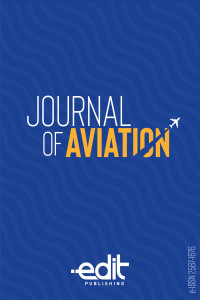Relationship Between Wingspan and Fuselage Length in Aircraft According to Engine Types
Relationship Between Wingspan and Fuselage Length in Aircraft According to Engine Types
Aircraft design, Wingspan, Fuselage length, Power correlation Aircraft sizing,
___
- Abubakar, M. R., Basuno, B., & Hasan, S. (2013). Aerodynamics Analysis on Unsymmetrical Fuselage Models. In Applied Mechanics and Materials (Vol. 315, pp. 273-277). Trans Tech Publications Ltd.
- Anderson, B. K., & Takahashi, T. T. (2017). Conceptual fuselage design with direct CAD modeling. In 17th AIAA aviation technology, integration, and operations conference.
- Ardema, M. D., Chambers, M. C., Patron, A. P., Hahn, A. S., Miura, H., & Moore, M. D. (1996). Analytical fuselage and wing weight estimation of transport aircraft.
- Bejan, A., Charles, J. D., & Lorente, S. (2014). The evolution of airplanes. Journal of Applied Physics, 116(4), 044901.
- Bronz, M. (2012). A contribution to the design of long endurance mini unmanned aerial vehicles (Doctoral dissertation, Institut Supérieur de l'Aéronautique et de l'Espace-ISAE).
- ICAO (1988). Annex 14: Aerodromes. International Civil Aviation Organ.
- ICAO (2017). Wake turbulence separation in RVSM airspace. Third meeting ATM SG/3-WP/27. Cairo, Egypt.
- Kruger, M., Huyssen, R. J., Smith, L., & Meyer, J. P. (2016). Application of a low fineness ratio fuselage to an airliner configuration. In 54th AIAA Aerospace Sciences Meeting (p. 1282).
- Liu, T. (2006). Comparative scaling of flapping-and fixed-wing flyers. AIAA Journal, 44(1), 24-33.
- Marta, A. C. (2008). Parametric study of a genetic algorithm using a aircraft design optimization problem. Report Stanford University, Department of Aeronautics and Astronautics.
- McDavid, J., & Kühner, B. (2017). Empennage Sizing: The Tail Lever Arm as a Percentage of Fuselage Length Determined from Statistics. Digital Library-Projects & Theses-Prof. Dr. Scholz.
- Nicolosi, F., Della Vecchia, P., Ciliberti, D., & Cusati, V. (2016). Fuselage aerodynamic prediction methods. Aerospace Science and Technology, 55, 332-343.
- Niţă, M., & Scholz, D. (2010). From Preliminary Aircraft Cabin Design to Cabin Optimization-Part Ii. Deutscher Luft-und Raumfahrtkongress DLRK, 2010.
- Raymer, D. (2018). Aircraft design: a conceptual approach. American Institute of Aeronautics and Astronautics, Inc
- Sforza, P. M. (2014). Commercial airplane design principles. Elsevier.
- Singh, V., Sharma, S. K., & Vaibhav, S. (2016). Transport aircraft conceptual design optimization using real coded genetic algorithm. International Journal of Aerospace Engineering, 2016.
- Jackson, P. (Ed.). (2004). Jane's All the World's Aircraft. Jane's. In various years.
- Torenbeek, E. (2013). Advanced aircraft design: conceptual design, analysis and optimization of subsonic civil airplanes. John Wiley & Sons.
- Wells, D. P., Horvath, B. L., & McCullers, L. A. (2017). The flight optimization system weights estimation method.
- Zhuravlev, P., & Zhuravlev, V. (2012). Significance of modifications for development of passenger airplanes. Aircraft Engineering and Aerospace Technology.
- Zlotnick, M., & Diederich, F. W. (1952). Theoretical Calculation of the Effect of the Fuselage on the Spanwise Lift Distribution on a Wing.
- Yayın Aralığı: Yılda 3 Sayı
- Başlangıç: 2017
- Yayıncı: Vedat Veli ÇAY
An Investigation on Hope and Life Satisfaction of Employees in the Aviation Sector in New Normal Era
Oğuzcan KURŞUNCU, Nisa SEÇİLMİŞ
Is Gamification Important for Service Systems Non-Users? A Study on Airline Loyalty Programs
Relationship Between Wingspan and Fuselage Length in Aircraft According to Engine Types
Cash Management of Multinational Airlines: A Case Study on A Turkish Airline
Çiğdem BOYACILAR ÇAĞLAR, Abdullah TÜRK
